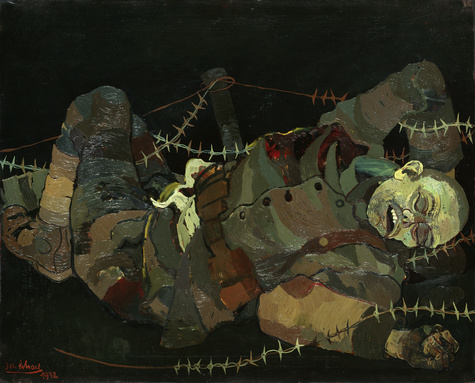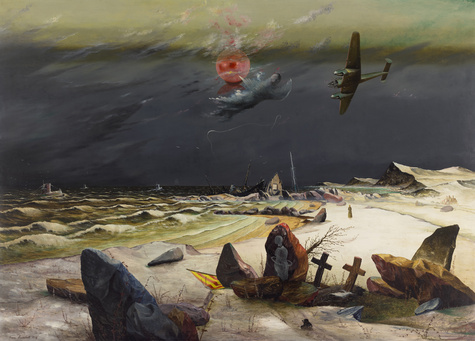19th century
Presentation of the collection –

The Städtische Galerie im Lenbachhaus (Municipal Gallery in the Lenbachhaus) opened in 1929 in the villa formerly owned by painter prince Franz von Lenbach (1836–1904), after enlargements to adapt the building to its new purpose. Well into the 1950s, the museum primarily collected and exhibited art by the painters of nineteenth-century Munich and early twentieth-century German art. This original focus as well as the art of Franz von Lenbach himself, our titular landlord, constitute the collection’s historic core.
A celebrated portraitist, Franz von Lenbach painted the likenesses of the pope, emperors, and kings, of elegant ladies and eminent figures from the worlds of politics and business (over the course of twenty years, he portrayed Otto von Bismarck around eighty times). At the apex of his career, he decided to make his permanent home in Munich—at the time Europe’s leading center of the arts, second only to Paris. From 1887 to 1891, he had a large artist’s residence in the Tuscan style built outside the city’s gates; the building housed his private apartment, studio, and museum. A stone’s throw away were two buildings containing the royal collections: the Pinakothek, the home of Old Masters such as Titian and Rubens, and the Glyptothek, where the exemplary art of classical antiquity was on display. Even today, the historic furniture and decorations of the villa’s representational rooms convey a sense of the atmosphere and aspirations of a late-nineteenth century artist’s residence.
In the nineteenth century, the "Munich school" enjoyed international renown, attracting artists to the city; collectors around the world prized their works. The local bourgeoisie took a lively interest in local art; the venue for this audience was the Münchner Kunstverein, founded in 1823, whose exhibitions primarily presented landscapes and genre paintings. As a municipal institution, the Lenbachhaus initially focused its collecting efforts on this more private and bourgeois art, in programmatic contradistinction to the Bavarian State Picture Collections, which built on the holdings of the Bavarian royal house and the activities of the Academy of Fine Arts.
A romantic conception of the landscape, realism informed by Gustave Courbet’s work, enthusiasm for the art of the sixteenth and seventeenth centuries, and the influences of Belgian, Dutch, French, and English painters helped shape the art produced in Munich. In the Lenbachhaus’s collections, these various manifestations are represented by eminent artists such as Wilhelm von Kobell, Johann Georg von Dillis, Thomas Fearnley, Ernst Kaiser, Christian E. B. Morgenstern, Carl Rottmann, Carl Spitzweg, and Eduard Schleich the Elder. Another group of works exemplifies the outstanding painterly quality of the Leibl circle (including Wilhelm Leibl, Carl Schuch, Wilhelm Trübner, and Hans Thoma). The collection also features an emphasis on selected representatives of academic painting such as Carl Theodor von Piloty, Hans Makart, Gabriel von Max, and Albert von Keller, and portraits by the so-called princes of painters, Franz von Lenbach and Friedrich August von Kaulbach.
The establishment of the Munich Secession in 1892 was an expression of new tendencies; the group united a wide variety of styles between Impressionism, Jugendstil, and the influence of avant-garde conceptions of the picture, as illustrated by paintings by Franz von Stuck, Lovis Corinth, Max Slevogt, Fritz von Uhde, and many others. These works mark the transition to the collection’s holdings of the art of the Neue Künstlervereinigung München and the Blauer Reiter. Art after World War I is repesented by an important selection of works of the Neue Sachlichkeit or New Objectivity. The historic ruptures of the Weimar Republic and the art politics of the Nazi regime are reflected in works such as "Portrait of Bertolt Brecht" (ca. 1926) by Rudolf Schlichter, Operation (1929) by Christian Schad, "Dead Soldier" (1932) by Josef Scharl, "Portrait of Oskar Maria Graf" (1918) by Georg Schrimpf, and "the U-boat War/Total War/Lost Soil" (1936- ca. 1960).
Over the years, we have frequently had the opportunity to add important individual works to our collection of nineteenth-century art, which has also grown thanks to substantial bequests.
The collection is rounded out by the bequest of estates and/or permanent loans such as the collection of the Munich Secession, the estate of Johann Georg von Dillis (owned by the Historical Society of Upper Bavaria), and the estate of the founder of "Simplicissimus," Th. Th. Heine.
When the house reopened in 2013, the Lenbachhaus hosted the first exhibition of the Christoph Heilmann Foundation’s holdings of paintings of German Romanticism and the Barbizon School, adding an international dimension to our nineteenth-century collection.




